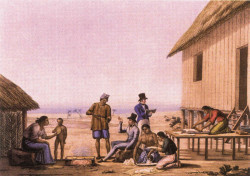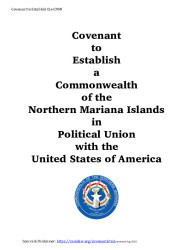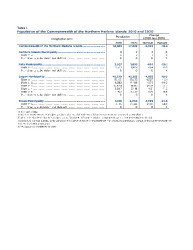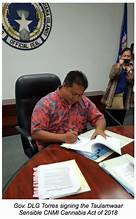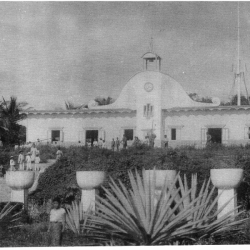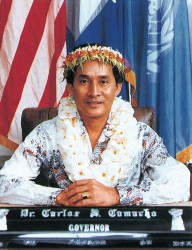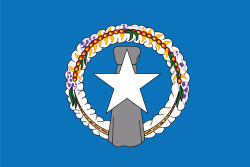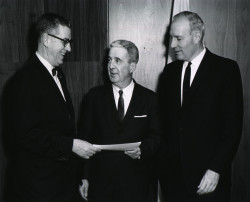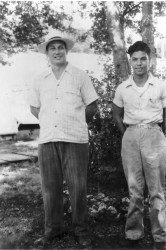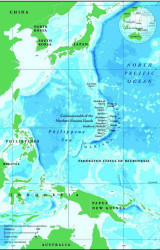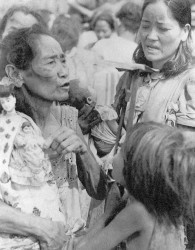Diann Torres's collections
Spanish Era 1521-1898 and Pueblo Life
<p>The Chamorros who survived the Spanish conquest adapted to new life. A new religion was introduced, clothing, daily practices, and more. The Manila Galleons continued to come in and out of the the islands bringing goods and commodities and new people to help the island government. Chamorros were moved to Guam after the war and lived the best life they could growing crops, bartering, raising livestock to meet their needs.</p>
6
NMI Covenant and Constitution
<p>Official documents of the CNMI. </p>
<p>The Commonwealth <strong><u>Constitution </u></strong>was created by thirty-nine elected delegates during a constitutional convention on Saipan in 1976. It was ratified by voters on March 6, 1977, and became effective on January 9, 1978. Key provisions, such as the bill of rights and the separation of government powers, are mandated by the Covenant. Notable events include the ratification of forty-four amendments in 1985 and eighteen amendments from various legislative initiatives between 1987 and 2014. </p>
<p>The <strong><u>Covenant </u></strong>to Establish a Commonwealth of the Northern Mariana Islands in Political Union with the United States is a mutually binding agreement that outlines the self-governing status of the Northern Mariana Islands within the American political framework. Negotiated over twenty-seven months by the Marianas Political Status Commission and a U.S. delegation, the Covenant was officially signed on February 15, 1975, in Saipan. The approval process involved unanimous endorsement by the Mariana Islands District Legislature on February 20, 1975, followed by a plebiscite on June 17, 1975, where 78.8% of eligible voters approved the Covenant. Subsequently, it received congressional approval and was signed into law by President Gerald Ford on March 24, 1976. Certain provisions became effective on that date, while others took effect on January 9, 1978, and November 4, 1986, the latter marking the date residents became U.S. citizens. Modifications to fundamental provisions require mutual consent from both the United States and Commonwealth Governments. A copy of the Covenant was submitted to the United Nations on March 3, 1975, for official circulation.</p>
2
Marianas-Southern Airway
<p>A new airline opens to provide additional transportation between our islands.</p>
5
Taulamwaar Sensible CNMI Cannabis Act of 2018
<p>Gov. Ralph DLG. Torres signed H.B. 20-178 into law, making the Northern Mariana Islands the first U.S. territory to legalize and regulate marijuana for adult use. It is also the first U.S. jurisdiction to do so through its legislature, rather than via ballot initiative.</p>
2
A period of Rapid Change: The German Era 1899-1914 Northern Mariana Islands History
<p>Germany purchased the Marianas, seeking international prestige and opening a new chapter in the islands' history. New economic ventures were introduce, the copra industry, transforming the local economy and providing new opportunities for the Chamorros and Carolinians. Germans trained the Chamorros and Carolinians in sustainable practices, fostering self-reliance and economic independence.</p>
<p>The Germans built good citizens through education and training, Germans emphasized camaraderie, punctuality, obedience, and technical knowledge, aiming to shape the Chamorros and Carolinians into exemplary citizens. Their presence in the Marianas lead to a unique cultural exchange, blending local traditions with new skills and ideas.</p>
<p>The German Era (1899-1914) leaves a lasting imprint on the Marianas, with developments in infrastructure, the industry, education, and community values still remembered today.</p>
5
The Boom Years
<p>The second constitutional convention of the Northern Mariana Islands took place in 1985, resulting in 44 amendments that were approved by voters, although one amendment limiting voting rights was later deemed unconstitutional. Key amendments included the establishment of Municipal Councils for Tinian and Rota and the creation of an autonomous Public School System with an elected governing board. In 1986, the U.S. government declared that the trusteeship agreement was no longer applicable, granting the people of the Northern Marianas U.S. citizenship and enforcing the covenant's remaining provisions. To maintain local policy control, the CNMI Supreme Court was established to handle appeals from the CNMI Superior Court.</p>
<p>During this period, private business thrived on Saipan, fueled by an influx of skilled workers from the Philippines, Japan, Korea, and China, which led to significant infrastructure challenges. Indigenous Chamorros and Carolinians faced legal issues regarding land purchases, prompting legislative action from the CNMI Legislature. The economy, particularly the tourism sector, expanded rapidly in the 1980s and 1990s, but the growing non-resident workforce, especially in garment factories, drew congressional scrutiny. Governor Froilan C. Tenorio sought to protect the CNMI's garment industry by hiring a lobbying firm, while subsequent governance changes led to continued efforts to reform labor and immigration administration amidst declining revenues.</p>
2
Marianas Reunification
<p>Political self-determination in the Northern Mariana Islands was achieved through a challenging process. The residents gained limited political experience under Spanish, German, and Japanese rule. Post-World War II, the United States, under the United Nations, pledged self-determination and self-government for Micronesia, including the Northern Mariana Islands.</p>
<p>Following the war, local governments were established, with the islanders participating in elections for municipal and district legislatures. Chamorro and Carolinian administrators gained valuable experience by implementing local legislature policies.</p>
<p>Desiring U.S. citizenship and a secure connection with the United States, the majority of Northern Mariana Islanders began the quest for citizenship in 1950. Polls in 1958, 1961, and 1963 showed support for reunification with Guam. Although Guam rejected reunification due to political reasons in 1969, the people of the Northern Mariana Islands voted in favor of reunification, leading them to pursue their distinct political status.</p>
2
The Evolution of the Northern Marianas Islands
<p></p>
<p>Around 42 million years ago, the Mariana Islands began to form as volcanoes emerged on the ocean floor due to movements in the Earth's crust. This was caused by the subduction of the denser Pacific Plate under the Mariana Plate, resulting in the creation of the Mariana Trench. The islands grew above a trough of hot magma along the Mariana Plate's edge. The region experiences earthquakes due to plate movements and volcanic activity.</p>
<p>The Mariana Islands consist of high volcanic and raised limestone islands. The older southern islands are raised limestone islands, while the younger ones to the north are high volcanic islands. Located in the tropics, the Marianas have a tropical climate with distinct seasons. Typhoons are common during the rainy season, posing significant challenges.</p>
<p>The islands' unique geology contributes to the formation of freshwater lenses in the porous limestone islands. Ancient volcanic eruptions and erosion processes have shaped the islands, creating diverse habitats for various forms of life. Coral reefs play a crucial role in the ecosystem, with different types of reefs found in the region. The barrier reefs protect the harbors and shorelines of the Marianas, making the coral reef systems one of the world's richest biological environments.</p>
<p></p>
4
Holocaust-Recovery Efforts
<p><strong>Impact of Air Raids on the Northern Mariana Islands</strong></p>
<p>The February, 1944 air raids on the Northern Mariana Islands devastated the prewar Japanese economy, plunging nearly every civilian into unemployment and poverty. The Chamorros and Carolinians experienced violence firsthand for the first time since the Spanish conquest, facing destruction from bombs and machine-gun attacks that spared no one.</p>
<p><strong>Desperate Aftermath of the Air Raids</strong></p>
<p>After the raids, chaos reigned as mothers searched frantically for their children amidst the screams of pain and anguish in the streets of various towns. While some Japanese nationals managed to leave on ships, many others, including Okinawans, Koreans, Chamorros, and Carolinians, were left trapped in the conflict between Japan and the United States on different islands.</p>
<p><strong>Invasion of the Marianas</strong></p>
<p>On June 11, 1944, Mitscher's planes signaled another wave of terror as civilians sought refuge in damaged buildings or ancient caves. The arrival of the American fleet on June 15 brought more destruction, with explosions and naval gunfire terrifying the population as Marines landed and battles ensued, leaving behind a grim scene of death and devastation.</p>
3

